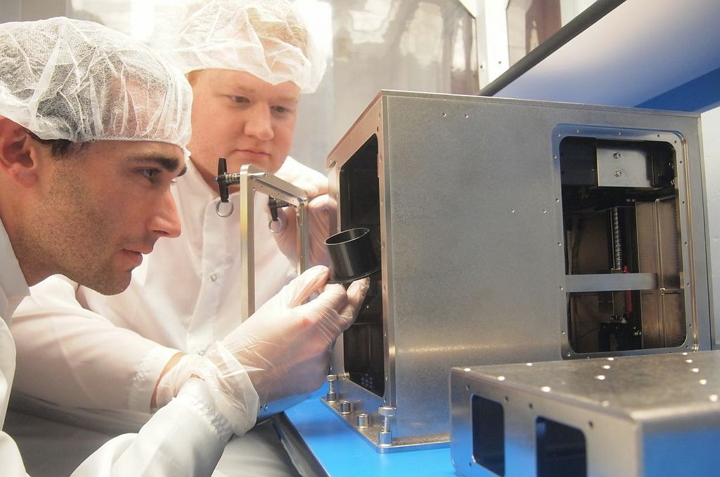 Made In Space and NanoRacks have been making news lately with the announcement of partnerships to change the way objects are imagined and built off the planet, and now the companies have joined forces to provide a novel new service for CubeSat developers.
Made In Space and NanoRacks have been making news lately with the announcement of partnerships to change the way objects are imagined and built off the planet, and now the companies have joined forces to provide a novel new service for CubeSat developers.
 They call it “Stash & Deploy,” and the service will leverage the NanoRacks heritage in CubeSat deployment and the capability of Made In Space to provide 3D printing capabilities and deliver – on-demand – satellite manufacturing, assembly, and deployment in the space environment.
They call it “Stash & Deploy,” and the service will leverage the NanoRacks heritage in CubeSat deployment and the capability of Made In Space to provide 3D printing capabilities and deliver – on-demand – satellite manufacturing, assembly, and deployment in the space environment.
The plan calls for a variety of standard and customer-specific satellite components to be “cached” within a satellite deployment vehicle such as the International Space Station, and the components will be “stashed” for rapid manufacture of CubeSats.
Made In Space, the space manufacturing company, and NanoRacks, the provider of commercial low-Earth orbit services, say the plan will change the way the satellites are made.
“This is a fundamental shift for satellite production. In the near future, we envision that satellites will be manufactured quickly and to the customer’s exact needs, without being overbuilt to survive launch or have to wait for the next launch,” says Andrew Rush, the president of Made In Space.
The companies say customers will be able to quickly design a satellite or request that a satellite be designed based on their specific requirements. As the satellites are designed, an “optimized structure” will be created in orbit and components will be integrated.
A satellite can then be deployed into low Earth orbit, and the entire assembly and deployment process will have occurred in a fraction of the time necessary to build, launch and deploy satellites from the ground. Both companies say this will mark the first time that this level of responsiveness will be available to satellite operators.
“Stash and deploy opens a new chapter in space utilization,” says Jeffrey Manber, the CEO of NanoRacks. “Looking out a few years, this option may be more desirable than launch and deploy.”
The companies say Stash & Deploy will make in-orbit assembly and deployment of small satellites a viable and attractive option for developers interested in pushing the edges of the envelope in modern space development. They add that the method will mean that developers can deploy hardware faster than traditional methods of CubeSat deployment now allow.
“Made In Space was founded with the belief that one day, entire spacecraft will be manufactured in space. With Stash & Deloy, NanoRacks and Made In Space make the first step towards this goal,” said the CTO and Co-Founder of Made in Space, Jason Dunn.
According to the agreement, the Stash & Deploy service will be available during the first quarter of 2016.
Made In Space, Inc. (MIS) was founded in 2010 when it became the world’s first space manufacturing company and was contracted by NASA to design, build, and operate the 3D Printing In Zero-G Experiment during 2014.
NanoRacks LLC was formed in 2009 to provide commercial hardware and services for the U.S. National Laboratory on board the International Space Station via what’s known as a Space Act Agreement with NASA. From their main office is in Houston, Texas, adjacent to the NASA Johnson Space Center, NanoRacks has become what they say is “the Operating System for Space Utilization.” The company has, to this point in time, deployed more than 200 payloads on the International Space Station.
How do you think this agreement between Made In Space and NanoRacks will impact the business of deploying CubeSats going forward? Let us know in the Made In Space and NanoRacks forum thread on 3DPB.com.
Subscribe to Our Email Newsletter
Stay up-to-date on all the latest news from the 3D printing industry and receive information and offers from third party vendors.
Print Services
Upload your 3D Models and get them printed quickly and efficiently.
You May Also Like
Heating Up: 3D Systems’ Scott Green Discusses 3D Printing’s Potential in the Data Center Industry
The relentless rise of NVIDIA, the steadily increasing pledges of major private and public investments in national infrastructure projects around the world, and the general cultural obsession with AI have...
3DPOD 260: John Hart on VulcanForms, MIT, Desktop Metal and More
John Hart is a Professor at MIT; he´s also the director of the Laboratory for Manufacturing and Productivity as well as the director of the Center for Advanced Production Technologies....
Etsy Design Rule Change Reduces Selection of 3D Printed Goods
Online marketplace Etsy has implemented a rule change requiring all 3D printed goods on the site to be original designs. The update to the site’s Creativity Standards states, ¨Items produced using...
E-Beam OEM Wayland Additive Partners with USC Racing to 3D Print Titanium Exhaust Collector
Every year, standards organization SAE International holds a competition called Formula SAE, in which students from both undergraduate and graduate programs design, build, and race small formula-style race cars. For...

































